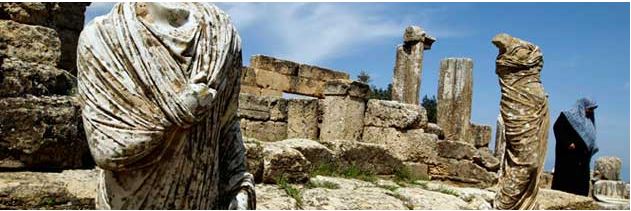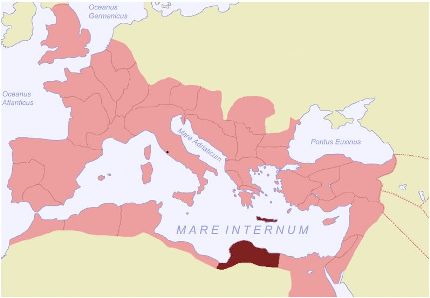Capitalizing on Existing Assets: Infrastructure and Planning

The disappointment of the Gaddafi government’s stewardship at Cyrene
An important Hellenic-Roman heritage site in eastern Libya, as recounted in a recent Kathemerini article by M. Abbas, reminded us of the planning that the Kommos Conservancy continues to invest in, towards producing a sustainable leveraged amenity for the Mesara in south central Crete. Where Shahaat, the neighboring town to the archaeological site of Cyrene has unaddressed short comings – the Cretan towns and villages of Pitsidia, Kamilari and Matala, near the Kommos archaeological site, offer the visitor plenty of good accommodation and restaurants.

Around the corner from Kommos lies the town of Matala which served as the Roman harbor for Gortyn. The beach restroom facilities there served as a model for the planned improvements at the Kommos site, as represented in the 2005 updated development plan. Combining changing room and toilet facilities, the design and construction are based on local materials and construction methods.
The Kommos site stands to benefit by its proximity to the provincial Roman capital at Gortyn, its beach location and the planning that has already taken place for visitor accommodation. The work plan for 2011 calls for fundraising and investment in additional planning to advance the regulatory approval based on the expanded schematic drawing to be evolved to design-development plans with accompanying estimate of probable cost.

The publication of a handbook by the American School of Classical Studies at Athens, written by Joseph Shaw, the foremost expert scholar on the site, provides immediate access to a layperson tourist why the site of Kommos matters.
In 69 BC Crete and Cyrenaica (the coastal portion of eastern Libya) became a Roman senatorial province, the capital for which was city of Gortyn, some 20 km from Kommos in the Mesara. Existing archaeo-tourism at Gortyn could benefit by a visit to the beautiful sandy beach at Kommos and its existing bar resturant. The Romans adapted a Hellenic temple at Kommos and its interpretation can supplement the visitor’s Roman experience at Gortyn.

A Libyan national refocus on heritage tourism had recently begun when Greek Prime Minister George Papandreou met Colonel Gadaffi almost a year ago when he flew to the Libyan capital Tripoli and solicited vague promises of financial help during Greece’s economic crisis. In 2007 Saif Al Islam the second eldest son of Colonel Gadaffi announced a bold plan to invest £1.5 billion centered on the archaeology of Cyrene and according to Gulfnews.com “The aim is to make the area ecologically friendly, to provide jobs to the unskilled and uneducated local population, and to excavate more of the area, one of the most important and untouched Greek sites. Attractions include the Temple of Apollo and and the partly unexcavated Temple of Zeus.” Given that the country is undergoing a civil war these conservation and archaeological park development goals will be indefinitely delayed.
The Kommos Conservancy archaeological park plans are available to view on our web site. We continue to compete for the necessary grant funding and appreciate private contributions, of any amount, which would contribute to the planning, infrastructure development and interpretation, which are all critical for the sustainable development and conservation of the Kommos site’s archaeological record.
Click here for Greek language version of this blog

30 June 2011 Circumstances have gotten worse!
ARCHAEOLOGICAL INSTITUTE OF AMERICA (AIA) CALLS ON U.S. AND LIBYA TO PROTECT WORLD HERITAGE SITES
The Archaeological Institute of America (AIA) urges caution in the wake of recent reports that military action is taking place at the Libyan World Heritage sites of the Old Town of Ghadamès and Leptis Magna, exposing both to potential damage or destruction.
“We fully support the statement made by the United Nations Educational, Scientific and Cultural Organization (UNESCO), which calls on the parties involved in the armed conflict in Libya to do everything possible to protect the World Heritage sites of the Old Town of Ghadamès as well as the archaeological site of Leptis Magna,” says Elizabeth Bartman, President of the Archaeological Institute of America.
The Old Town of Ghadamès, known as “the pearl of the desert,” was recently shelled, according to media reports. The London Times reported, “Gaddafi’s forces took over the ruins of Leptis Magna as a base for operations,” and said that Libyan government troops moved rockets and munitions into this World Heritage Site. If true, this action may have placed this unique archaeological site under direct threat of attack.
“It is our shared responsibility as citizens of the world to be aware of the devastating loss that would result from the destruction of these sites,” says Peter Herdrich, CEO of the Archaeological Institute of America. “By bringing their value to light, we trust that neither side will be responsible for destroying our common heritage.”
Saif al-Islam Gaddafi who was hoping to capitalize on the ancient Hellenistic Greek site Cyrene was captured today and as the BBC news article indicates this is a very significant moment for Libyans. They came to see Saif al-Islam as the heir apparent, as a younger version of his father due to his rhetoric during the uprising. However, at one time he was considered one of the more liberal of Col Gaddafi’s sons and was courted in the West. Meanwhile heritage tourism is probably a lesser priority and stewardship for Cyrene, is probably on hold. Hopefully Kommos will get the political support for potential economic development.
Tripoli and Benghazi: A New Future for the Past
By Karen Dabrowska
23 February 2012
In a recent lecture Dr Paul Bennett the Director of the Canterbury Archaeological Trust and the head of the Society for Libyan Studies stated that although there is greater regard for archaeology and heritage assets as potential revenue-earners for tourism and job creation, nothing has been done as yet to improve the effectiveness of the Department of Antiquities – the curator, custodian and protector of Libyan heritage. Not one of Libya’s World Heritage Sites has a Management Plan.
There are four projects that have sought to promote and protect Libyan heritage and support the revitalisation of the Department of Antiquities namely: The Green Mountain Project’ for a sustainable future – implementing the Cyrene Declaration of September 2007; ‘City Code’: Tripoli Old City rehabilitation project; The Benghazi Urban Charter’ – a 30 year plan for the city of Benghazi and ‘A Five Year Strategy for the Department of Antiquity of Libya’.
The Green Mountain Project stemmed from the Cyrene Declaration of 2007 when Gaddafi’s government recognised a significant part of the Green Mountain as a protected zone, with the ancient site of Cyrene ( A Roman city) as a centrepiece.
The main recommendation was for the establishment of protective ‘buffer’ zones for the most important sites in the Green Mountain Area (Cyrene, Apollonia, Ptolemais and Tocra).
Recommendations were made to rehabilitate the near-abandoned, Italian-built villages of Tolmeita, Susa and Tocra, partly in recognition that Ottoman and Italian buildings also formed part of Libyan heritage, but principally to provide new homes for Libyan families and facilities for tourists.
A proposal to use abandoned Italian farm and military buildings for tourist use was also put forward together with a scheme to use the site of Tocra as a training school for a new generation of Libyan archaeologists and heritage managers.
Connect through the link below to read the rest of Dabrowska’s story.
excepted from: http://tripolipost.com/articledetail.asp?c=4&i=7931
gone for bad: http://theartnewspaper.com/articles/Farmers-bulldoze-ancient-tombs-in-Libya-to-sell-plots-to-developers/30395
After ousting the dictator and providing for increased capacity to make local decisions, this decision erases the possibility for heritage stewardship.
Political Turmoil Benefits Black Market in Antiquities
http://archaeology.org/news/1538-131120-looting-syria-egypt-libya#.Uo4fu5iK-3o.twitter
In her blog “Organically Cooked: Linking Greek food with Greek identity,” Maria Verivaki relates that some 15000 Chinese were evacuated in 2012 from Ghaddafi-ruled Libya to Crete. This raised hopes that Cretans might introduce the Chinese to Cretan foods and products and might promote Chinese tourism. Her blog post may be found at:
http://www.organicallycooked.com/2012/02/visitors.html